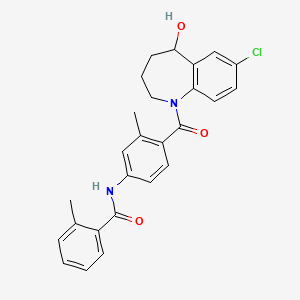D1129 | tolvaptan
C
C03XA01 Tolvaptan
[C03XA] Vasopressin antagonists
[C03X] OTHER DIURETICS
[C03] DIURETICS
[C] Cardiovascular system
| Toxicity | Dose | Time | Species | Model | Method | Action | Positive criterion | Reference |
|---|---|---|---|---|---|---|---|---|
| MEMBRANE POTENTIAL | 17.44±8.01 | human | qHTS-HepG2 | MMP assay | decrease | IC50 | 163 | |
| MEMBRANE POTENTIAL | 19.45 | human | HepG2 | MMP assay | decrease | IC50 | 163 | |
| MEMBRANE POTENTIAL | 17.41±2.00 | rat | hepatocytes | MMP assay | decrease | IC50 | 163 | |
| Pictogram | Signal | Statements | Precautionary Statement Codes |
|---|---|---|---|
 |
Warning |
Aggregated GHS information provided by 2 companies from 1 notifications to the ECHA C&L Inventory. Each notification may be associated with multiple companies. H361 (100%): Suspected of damaging fertility or the unborn child [Warning Reproductive toxicity] H362 (100%): May cause harm to breast-fed children [Reproductive toxicity, effects on or via lactation] Information may vary between notifications depending on impurities, additives, and other factors. The percentage value in parenthesis indicates the notified classification ratio from companies that provide hazard codes. Only hazard codes with percentage values above 10% are shown. |
P201, P202, P260, P263, P264, P270, P281, P308+P313, P405, and P501; (The corresponding statement to each P-code can be found at the GHS Classification page.) |
|
H413: May cause long lasting harmful effects to aquatic life [Hazardous to the aquatic environment, long-term hazard] |
P273, and P501; (The corresponding statement to each P-code can be found at the GHS Classification page.) | ||
| Organism | Test type | Route | Dose (normalized dose) | Effect | Source |
|---|---|---|---|---|---|
| guinea pig | LD50 | intraperitoneal | 198mg/kg (198mg/kg) | Journal of Pharmacology and Experimental Therapeutics. Vol. 77, Pg. 54, 1943. | |
| mouse | LD50 | intraperitoneal | 991mg/kg (991mg/kg) | lungs, thorax, or respiration: pleural effusion | Journal of Pharmacology and Experimental Therapeutics. Vol. 77, Pg. 54, 1943. |
| (+-)-4'-((7-Chloro-2,3,4,5-tetrahydro-5-hydroxy-1H-1-benzazepin-1-yl) carbonyl)-o-tolu-m-toluidide | (+-)-4'-((7-Chloro-2,3,4,5-tetrahydro-5-hydroxy-1H-1-benzazepin-1-yl)carbonyl)-o-tolu-m-toluidide | 150683-30-0 |
| 4CA-1265 | 5-hydroxy-7-chloro-1-[2-methyl-4-(2-methylbenzoylamino)benzoyl]-2,3,4,5-tetrahydro-1h-benzazepine | 683T300 |
| 7-Chloro-5-hydroxy-1-(2-methyl-4-(2-methylbenzoylamino)benzoyl)2,3,4,5-tetrahydro-1H-1-benzazepine | 7-chloro-5-hydroxy-1-[2-methyl-4-(2-methyl benzoyl amino) benzoyl]-2,3,4,5-tetrahydro-1H-1-benzazepine | 7-chloro-5-hydroxy-1-[2-methyl-4-(2-methylbenzoylamino) benzoyl]-2,3,4,5-tetrahydro-1H-1-benzazepine |
| 7-chloro-5-hydroxy-1-[2-methyl-4-(2-methylbenzoylamino)benzoyl]-2,3,4,5-tetrahydro-1H-1-benzazepine | AB0009995 | AB01565822_02 |
| AB2000685 | AC-22748 | AK-33401 |
| AKOS015994735 | AM20090726 | ANW-59865 |
| API0024498 | AX8158397 | BDBM35723 |
| Benzamide, N-(4-((7-chloro-2,3,4,5-tetrahydro-5-hydroxy-1H-1-benzazepin-1-yl)carbonyl)-3-methylphenyl)-2-methyl- | Benzamide, N-[4-[(7-chloro-2,3,4,5-tetrahydro-5-hydroxy-1H-1-benzazepin-1-yl)carbonyl]-3-methylphenyl]-2-methyl- | C26H25ClN2O3 |
| CAS-150683-30-0 | CHEBI:32246 | CHEMBL344159 |
| CS-0572 | CT0200 | CTK8B8272 |
| DSSTox_CID_28706 | DSSTox_GSID_48780 | DSSTox_RID_82975 |
| DTXSID3048780 | FT-0645839 | GTPL2226 |
| GYHCTFXIZSNGJT-UHFFFAOYSA-N | HMS3604L08 | HMS3656K20 |
| HMS3744A09 | HSDB 8196 | HY-17000 |
| KS-1315 | L001628 | N-(4-(7-Chloro-5-hydroxy-2,3,4,5-tetrahydro-1H-benzo[b]-azepine-1-carbonyl)-3-methylphenyl)-2-methylbenzamide |
| N-(4-(7-Chloro-5-hydroxy-2,3,4,5-tetrahydro-1H-benzo[b]azepine-1-carbonyl)-3-methylphenyl)-2-methylbenzamide | N-[4-(7-Chloro-5-hydroxy-2,3,4,5-tetrahydro-benzo[b]azepine-1-carbonyl)-3-methyl-phenyl]-2-methyl-benzamide | N-[4-(7-chloro-5-hydroxy-2,3,4,5-tetrahydro-1-benzazepine-1-carbonyl)-3-methylphenyl]-2-methylbenzamide |
| N-[4-(7-chloro-5-hydroxy2,3,4,5-tetrahydro-1-benzazepine-1-carbonyl)-3-methylphenyl]-2-methylbenzamide | N-[4-(9-chloro-6-hydroxy-2-azabicyclo[5.4.0]undeca-8,10,12-triene-2-carbonyl)-3-methyl-phenyl]-2-methyl-benzamide; | N-[4-[(7-Chloro-2,3,4,5-tetrahydro-5-hydroxy-1H-1-benzazepin-1-yl)carbonyl]-3-methylphenyl]-2-methylbenzamide |
| NCGC00183001-01 | OPC 41061 | OPC-41061 |
| OPC-41061(TOLVAPTAN) | PDSP1_001738 | PDSP2_001721 |
| Q426132 | SCHEMBL242421 | SR-01000942265 |
| SR-01000942265-1 | ST24031322 | SW219182-1 |
| Samsca | Samsca;OPC-41061 | TC-148610 |
| Tolvaptan | Tolvaptan (OPC-41061) | Tolvaptan [USAN:INN:BAN] |
| Tolvaptan, >=98% (HPLC), powder | Tox21_113256 | ZINC000000538658 |
| benzazepine derivative, 32 | s2593 | tolvaptan-opc-41061 |

